Who is Smarter - Cats or Dogs?
Josh Fischman, Battle of the Brains
 Scientific American Senior Editor Josh Fischman translates the results from research on the brains and neurons of cats, dogs, raccoons, bears and humans. You may be surprised by the results. Cat lovers - brace yourself.
Scientific American Senior Editor Josh Fischman translates the results from research on the brains and neurons of cats, dogs, raccoons, bears and humans. You may be surprised by the results. Cat lovers - brace yourself.
Josh Fischman is the Editor of Scientific American and wrote an article called, "Battle of the Brains" to measure the cognitive power of cats and dogs. So which one is smarter?
Josh explains that dogs have more neurons, so does that correlate to brain size or intelligence? Josh says that these are two different things. Having more neurons does correlate to brain size. However, it does not really correlate to smartness, because what is smartness? Cats have certain kind of behaviors and dogs have a different kind of behavior. Do these things make one of these animals smarter than the other?
When it comes to smartness, there are lots of different kinds. There is physical smartness, emotional smartness and even mathematical smartness. Josh tells us there is some evidence, as some studies have been done, showing that dogs are better able to hold problems in their working memory and solve them than our cats. That is one reason why you see dogs looking for explosives in airports and dogs as assistance animals. There are very, very few assistance cats!
Scientists wanted to know the answer to this so that is why they undertook this research. They thought they were not going to be able to settle this with subjective definitions of what is smartness, but they could count cells. They could particularly count the cells that are in the part of the brain that does complicated thinking. It's called the neocortex, which is a part of the cerebral cortex concerned with sight and hearing in mammals and is regarded as the most recently evolved part of the cortex.
Herculano-Houzel is a Neuroscientist at Vanderbilt University who decided that she actually had a way of counting these cells. So just how do you count cells? Josh tells us you take brains and you turn them into kind of soup. (He also explains that science is messy sometimes!) Herculano-Houzel was able to figure out a methodology where you take the brain and you cut away the neocortex, that outer little line, and you put it in essentially a blender and you turn it into soup. It then ends up looking a little bit like unfiltered apple cider.
Then once you turn this into a liquid, you can put a molecular probe in that acts kind of like a very specific fishhook that only grabs neurons. Then you can just count the neurons. Once you count the neurons, you can compare that count in animals. Herculano-Houzel did this with a cat, dog, raccoon, human and a bear.
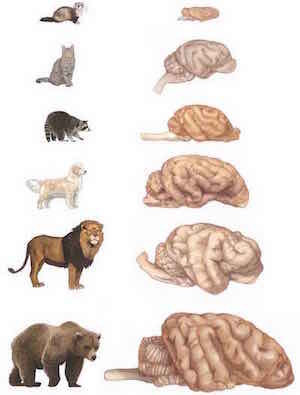 So who had the most brain cells? Of course the human came first. The count of neurons in the neocortex in humans is about 16 billion. Dogs have 429 million neurons. The cat was next and has almost half of what a dog has, or 250 million neurons.
So who had the most brain cells? Of course the human came first. The count of neurons in the neocortex in humans is about 16 billion. Dogs have 429 million neurons. The cat was next and has almost half of what a dog has, or 250 million neurons.
Surprisingly, raccoons have 438 million neurons, which is more than a dog. However, they have it packed into a cat size brain, which is half the size of a dog. If you've ever tried to keep a raccoon out of your garbage, you can understand this!
Another surprise was the bear, given how big they are and how big their brains are, they only have 250 million neurons. A bear's brain is 220 grams, which is close to seven times the size of a dog. So when Winnie the Pooh talked about being a bear with a very little brain, he was telling the truth! Bears seem to get by largely upon brawn. They hibernate and are very opportunistic. Josh tells us about a great Webcam of a national park up in Alaska called Explore.org. The bears actually stand in the middle of a waterfall letting the salmon jump into their mouths. It doesn't take a lot of brains to do that. But if they actually had to go and figure out where to find the salmon and catch them, or even bait a hook, they would be in big trouble. Josh says he would rather have a raccoon brain or even dog brain instead of a bear brain.
So is training a cat beyond their mental capacity or is it because they just don't want to be trained? Josh tells us that nobody has actually answered the, "beyond the mental capacity" question. But now that we have numbers on the neurons, we can look at that and be able to answer questions like, "How many neurons do you need to solve these kinds of problems?"
Bottom line, when it comes to the most brain cells of the mammals that were tested, humans are the smartest by a mile, because they've got more neurons. Next is raccoons, then dogs, followed by cats and bears who are pretty much tied.
You can find the article, "Battle of the Brains," in the Scientific American.
Visit Website
Two KONGs For Every Dog In America
Joe Markham, Founder of KONG Dog Toys
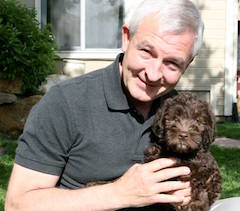 The KONG is the most ubiquitous dog toy in existence. The name KONG has become a part of the vernacular, just like Kleenex and Band-Aid. So, you'll be quite amused when KONG creator Joe Markham tells us how the toy was invented by accident.
The KONG is the most ubiquitous dog toy in existence. The name KONG has become a part of the vernacular, just like Kleenex and Band-Aid. So, you'll be quite amused when KONG creator Joe Markham tells us how the toy was invented by accident.
Joe Markham is the Founder of KONG Products and chances are if you have a dog, you have a KONG product in your home. While the KONG dog toy is a great product, Joe explains that he can only take half of the credit for it, with the rest of the credit going to his dog Fritz.
Fritz was a rock chewing German Shepherd who actually brought what was a part of a Volkswagen suspension from underneath a workbench to Joe and dropped it on his foot one day. Joe saw what Fritz needed, because they'd been on a quest for a long time to find an alternative for Fritz to chew on, as about a third of his teeth were already worn down from the rocks.
This was years ago when Joe was a motorcycle guy. He didn't have a lot to do in the wintertime, so he worked on Volkswagens. VW's were air cooled and very similar in a lot of ways with the tools and things that he was already using. So there were some parts leftover from the winter before and Fritz went through them and found just what he was looking for.
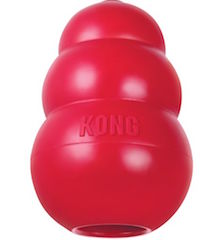 If you notice, the traditional shape of KONG dog toy is actually like the suspension portion and that a 67 VW Bus has a strangely familiar looking part on it now that resembles a Kong! What Fritz brought to him that day also had a big metal bracket on it because it mounted on the top of the transaxle to keep it from bumping against the frame. Of course Joe pulled the metal bracket off and gave it to Fritz. This all took place in 1970, just to give you an idea how long ago it was.
If you notice, the traditional shape of KONG dog toy is actually like the suspension portion and that a 67 VW Bus has a strangely familiar looking part on it now that resembles a Kong! What Fritz brought to him that day also had a big metal bracket on it because it mounted on the top of the transaxle to keep it from bumping against the frame. Of course Joe pulled the metal bracket off and gave it to Fritz. This all took place in 1970, just to give you an idea how long ago it was.
Okay, we now have the toy but where did the name come from? Joe explains that some of his friends wanted to invest in his new idea of a dog toy. They were all looking at it and saying what should we name it? Someone said Bee Hive, along with other names, but they just didn't sound right to Joe. Someone had just come from seeing the remake of the movie King Kong and said that the toy should be the earplug for King Kong. Joe said it was KONG for sure! It's strong like him. So that's where it came from. It turned out that it wasn't trademarked in his class of trade, so he was able to secure the name.
KONG has gained attention worldwide and is sold in 82 countries and counting, with printing in 14 languages. Joe says they are trying to figure out how many they've sold. In Golden, Colorado, they've got fourteen presses running that are giant and twenty feet tall. They make about 700 pounds of KONGS a shift, and they are pretty much running 24/7. So he's thinking they've sold close to 100 million, basically one or more for every dog in the world.
 The KONG started off as just a throwing toy for dogs to chase, catch and chew. You throw it, you get them interested in playing with it and it's a great toy like that on its own. However, all kinds of things have been put inside of KONGS . This includes dog food by spraying a little moisture on the food and putting it in there and freezing it. People also put whatever their dog's favorite treats are inside by placing the treats underneath some food inside of the KONG to stimulate them to find the most valuable treasure inside. Peanut butter, of course, is the old standby. Joe has also made something he calls Easy Treat. It's a real convenient spray that you can spray inside of a KONG . It comes out of the can very slowly and is like a liquid peanut butter.
The KONG started off as just a throwing toy for dogs to chase, catch and chew. You throw it, you get them interested in playing with it and it's a great toy like that on its own. However, all kinds of things have been put inside of KONGS . This includes dog food by spraying a little moisture on the food and putting it in there and freezing it. People also put whatever their dog's favorite treats are inside by placing the treats underneath some food inside of the KONG to stimulate them to find the most valuable treasure inside. Peanut butter, of course, is the old standby. Joe has also made something he calls Easy Treat. It's a real convenient spray that you can spray inside of a KONG . It comes out of the can very slowly and is like a liquid peanut butter.
This all happened by accident and KONG has turned out to be a blessing for all the dogs in the world, according to Joe.
Visit Fear Free Happy Homes for tips on making your home fear free and to locate a Fear Free Veterinarian near you. Go to Fear Free Pets to become certified.
Listen and Explore the Fear Free Expert Series
Coyotes Stalking our Neighborhoods - Dr. Debbie
 I just saw a scraggly coyote in front of my house one morning - the second coyote sighting in my neighborhood in a week. I feared what could have happened if my 15 pound terrier was outdoors alone. Wildlife is beautiful, but when my little terrier, Boss, is in harm's way - my doggie momma protective instincts kick in. While not a threat to be exaggerated, the coyote nonetheless poses a risk to our pet's safety.
I just saw a scraggly coyote in front of my house one morning - the second coyote sighting in my neighborhood in a week. I feared what could have happened if my 15 pound terrier was outdoors alone. Wildlife is beautiful, but when my little terrier, Boss, is in harm's way - my doggie momma protective instincts kick in. While not a threat to be exaggerated, the coyote nonetheless poses a risk to our pet's safety.
Coyotes are increasingly becoming a concern in urban areas - some are displaced by the urban sprawl that consumes their potential habitat. But other coyotes become urbanized savvy to living, feeding and thriving within city environments. Coyotes are born opportunists and dine on what they find available. They eat small animals like rabbits and rodents, but also consume ample vegetable matter with up to 40-percent of their diet consisting of seeds, grasses, fruits and flowers.
The most serious coyote concern for pets is injury and predation. As a veterinarian, I can recall many a client whose pet was brought in injured by unknown wildlife or whose cat just one day reportedly just vanished. While many might believe their cat was stolen, in reality these cats most likely fell victim to coyote predation. Likewise, small to medium sized dogs can be injured or lost to the same fate as their feline counterparts.
Steps to Keep Your Pet Safe
Whether you have pets or not, it's important not to feed coyotes. Intentional feeding of coyotes makes them dependent on humans and less fearful which increases the chance of an unwanted, dangerous interaction with people or pets. Just leaving unsecured garbage is invitation enough for these opportunists. Secure all garbage in closing containers and avoid leaving bagged garbage at the curb overnight. Pick up uneaten pet food as soon as your pet has finished eating.
Pet owners should take precautions to keep their household pets protected as well. Keep cats indoors and maintain all pets on leash control when outdoors. Ensure your dogs and cats are up to date on their rabies vaccines. Even indoor cats that do not venture outdoors should be current on this vaccine for both pet and human safety.
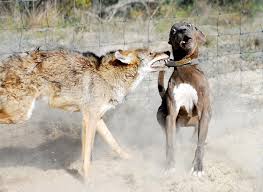 Besides rabies, keep your pets current on other vaccinations, deworming and preventatives as recommended by your veterinarian. Coyotes are known to harbor carry skin mites, canine distemper virus, canine parvovirus, adenovirus and heart worm disease. So even if your dog never leaves your yard, there is potential for infectious disease crossover between wildlife and your pet.
Besides rabies, keep your pets current on other vaccinations, deworming and preventatives as recommended by your veterinarian. Coyotes are known to harbor carry skin mites, canine distemper virus, canine parvovirus, adenovirus and heart worm disease. So even if your dog never leaves your yard, there is potential for infectious disease crossover between wildlife and your pet.
These wild canids are masters at adapting to their changing world, and it's unrealistic they are going away on their own. As humans we are the ones that need to change to make urban areas less appealing, removing easy feeding sites, and by raising awareness to the potential crossover between wildlife and pets.
Featured veterinarian known as "Dr. Debbie" on national pet radio program, Animal Radio. Ebook author of "Yorkshire Terriers: How to Be Your Dog's Best Friend"; "Pugs: How to Be Your Dog's Best Friend"; "Mini Schnauzers: How to Be Your Dog's Best Friend"; and "Shih Tzu: How to Be Your Dog's Best Friend." Dr. Debbie's books.
Visit Website
Animal Radio News - Lori Brooks
 Has Your Pet Restricted Your International Travel Plans?
Has Your Pet Restricted Your International Travel Plans?
So how many times have you been to Europe since you've had your pet? According to a study of 2,000 American pet parents, half of them have never traveled outside of the country since owning their pet. The study paid for by Trusted House-sitters looked at lifestyle impacts and responsibilities that come with having a pet. While one in two pet parents felt their international travel has been halted, as many as 33-percent will alter their travel plans because of their pets and prefer to travel only within the U.S. The main reason pet owners struggle to take a vacation without their pet is likely due to the 68-percent who felt especially guilty when they leave their pets behind. The research confirmed that, for animal lovers, their pet is part of the family. In fact, 84-percent said they view their pet on equal terms as a family member. This is especially true for young people who are choosing pets instead of children. Forty-six percent of older Millennials admit to treating their pet like their own child. Three in 10 respondents arrange for a pet sitter to stay in their home while they are away so that their pets can stay in their own environment. However, it's not only vacations that are difficult for pet parents, who the study says also attended fewer social events than those who don't have a pet. In fact, the average pet owner misses out on 30 social events a year. Which is why it should come as absolutely no surprise that pet owners use their pet as an excuse to flake on social gatherings at least once a month and nearly one in five pet owners will attend a social gathering only to leave early so they can get back to their pet or use that as an excuse to leave early.
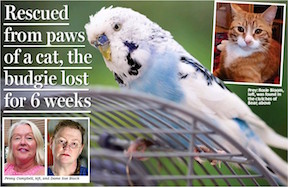 Cat Returns Missing Parakeet
Cat Returns Missing Parakeet
A parakeet, which was missing for six weeks, was reunited with its owner after a cat caught it. Penny Campbell had almost given up hope of ever seeing her bird Rosie Bloom again after she escaped her home. However, a cat living about a mile away brought the parakeet into its house and the owners managed to catch it and take it to a local vet. A Facebook post alerted Rosie's owner to check at the vet's office. The bird had been living outside on her own and feeding herself until the proud cat caught her and took her into his home to show his family. Rosie is back home now and doing well, no worse for the wear.
Your Cat Could Be Giving Away Your Home Address
Identity theft has been a big concern for years. Now those photos you post of your pet could lead strangers straight to your home. The metadata hidden beneath those cute furry photos include your geo-location. And one website, IKnowWhereYourCatLives.com, actually highlights just that. They took the metadata from cat photos on Instagram and compiled a visual map of where those photos were taken. Here's how to turn off location services for photos on your phone: iPhone: Settings - privacy - location services - camera - instead of "using the app" click 'Never.' For Android phones: Go to the camera - settings - location tags - make sure it's off.
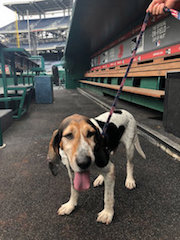 Bucket List For Shelter Dog
Bucket List For Shelter Dog
An animal shelter in Arlington, Virginia, helped a dying dog with cancer live his best life. The shelter created a bucket list for Smoke. On the list were entries such as finding a forever family, going on a hike, riding in a fire truck, eating ice cream, going to the beach, having a birthday party, riding in a police car and howling with the sirens, getting a full body doggy massage, meeting Santa Claus and throwing out the first pitch at a major league baseball game.
 Listen to the entire Podcast of this show (#1165)
Listen to the entire Podcast of this show (#1165)





